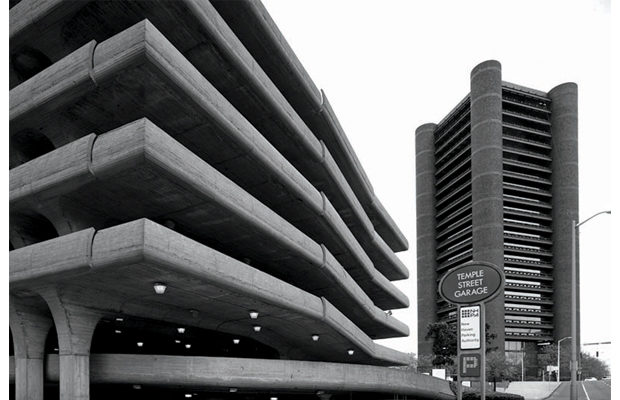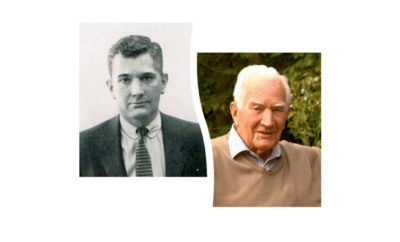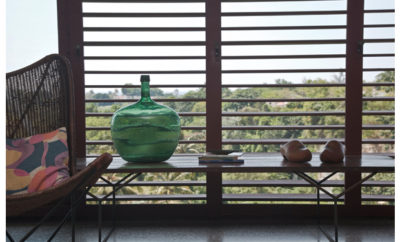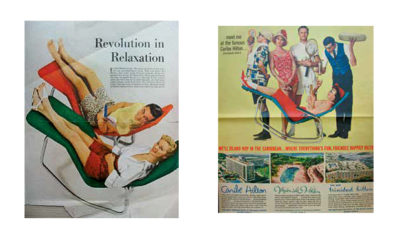
Architecture
America the Brutal
A MIAMI PHOTOGRAPHER IS SEDUCED BY THE RUGGED POWER OF AMERICA’S BRUTALIST BUILDINGS

When photographing Paul Rudolph’s Art and Architecture building of 1963 for the Yale School of Architecture in New Haven, I was happy to find two students walking by, providing a sense of human scale.
BRUTALISM IS WELL-NAMED, a provocative architectural style that the words sculptural and threatening, honest and overbearing, monumental and claustrophobic all battle to describe. The architect Paul Rudolph may have brought the style to America a half-century ago with his loved- hated-loved-hated Art and Architecture Building for the Yale School of Architecture, where he was dean, but in his wake, every major metropolis and many small to medium-sized towns across the United States came to feature raw concrete monoliths shaped into city halls, parking garages, federal courthouses, and public housing projects, many designed by lesser architects than Rudolph and certainly lesser architects than Rudolph’s inspiration, Le Corbusier.
As an architectural photographer, I often find myself in what the venerable Ada Louise Huxtable once called “the architectural abyss.” That chasm finds its widest berth in brutalism. I started my architectural photography career shooting vernacular mid-century modern buildings and went on to shoot such important buildings and places as Philip Johnson’s Glass House and the campus of Florida Southern College with its array of Frank Lloyd Wright buildings. But not-always-easy brutalist buildings continued to intrigue me. A few years ago, I decided to start photographing these behemoths.
A good starting point was New Haven and the Yale Art and Architecture Building, finished in 1963. At the time its structural monumentality, complex interior layout (there are thirty levels on seven stories), and rugged honesty came together to win hyperbolic praise spearheaded by none other than Huxtable, who proclaimed the building a “spectacular tour de force.”
From the start there were serious criticisms of it as well, both in terms of its function and its form. The epic photographs of Ezra Stoller documented its raw sculptural power, made all the more heroic through his gorgeous high contrast black-and-white prints, which gave the building an aura of invincibility and strength. But they did not document the human response to the building; students often found themselves lost in the labyrinthine maze of concrete corridors and differing levels of a building frigid in winter and sweltering in summer. And alas, the invincibility that Stoller’s images portray was once and for all seriously brought into question by a suspicious fire in 1969. Yet at the time, the combination of Rudolph’s architecture and Stoller’s photography gave great momentum to brutalism.
In New Haven I ventured down a side street to find two students strolling past the concrete, allowing my image to show both the size and scale of the building and offer a differing view from Stoller’s classic full-frontal images.

T. Trip Russell and Associates’ Miami-Dade County School Board building dwarfs the lone cyclist I photographed riding by it. Its cavernous front plaza looms over Northeast Second Avenue, adding a sense of drama to the streetscape.
A lone cyclist careering down Northeast Second Avenue past the Miami Dade County School Board building designed by T. Trip Russell and Associates, gave some dimension to the muscular proportions of this ominous looking structure, with its jagged teeth descending from the roofline and its massive square arch protruding over an open plaza.
Perhaps the most revered and reviled brutalist building in America is Boston City Hall, which has managed to generate controversy since its completion in 1969. Designed by Kallmann McKinnell and Knowles, it is either (as it was hailed at the beginning) a bold testimony to monumental governmental architecture or a badly aging, malfunctioning eyesore, as its critics would say. Nonetheless, it generated its own offspring, including the former City Hall in West Palm Beach. Set on its own plaza, this T-shaped building projects its upper stories over the lower portion in an inverted ziggurat. Further north in Orlando I found the public library designed in 1966 by John M. Johansen. Now occupying an entire city block, the structure offers the very definition of architectural chutzpah, yet it’s also a bold statement of social purpose and government largesse, and its rigorous geometry was a delight to photograph.

The former City Hall of West Palm Beach reminds me of an inverted ziggurat, a geometry it shares with the City Hall in Boston.
Two other brutalist structures in New Haven stand adjacent to one another—the Temple Street Parking Garage by Rudolph and the twenty-three-story Knights of Columbus Headquarters designed by Kevin Roche and John Dinkeloo in 1970. Rudolph’s Temple Street Garage rips through the heart of downtown New Haven, yet its gently undulating forms are delicate and eloquent. When I looked through my viewfinder, Rudolph’s exquisite knowledge of geometric form came squarely into view, providing a surprisingly quiet composition, quite at odds with the muscularity of the construction. It is this type of contradiction that I find so compelling about brutalism: brutal and defiant on one hand and distinctive and sculptural on the other.
Roche Dinkeloo’s Knights of Columbus tower rises with imposing authority over downtown New Haven, the cylindrical corners lending the building a simple but dramatic geometric form. The design is fortress-like, with the cylindrical forms covered in burned brick—quite unusual for a brutalist building, which usually feature reinforced concrete.
Many of these buildings have not fared well, particularly in the Northeast, where the climate plays havoc with the raw concrete, creating dark stains and maintenance headaches. Another famous Rudolph building, the Orange County Government Center in Goshen, New York, is now under threat of demolition but is also the subject of a preservation effort led by the World Monuments Fund. The building is a lightning rod for those who vehemently hate it and a powerful symbol to those who recognize it as the work of a master architect, providing us with another seemingly unbridgeable example of the architectural abyss.

Photographing Rudolph’s Temple Street Parking Garage and Roche Dinkeloo’s striking Knights of Columbus Headquarters in New Haven provided me with an intriguing juxtaposition of differing geometries, one filling the horizontal plane, the other piercing the vertical.
As an architectural photographer seeking out strong interplays of light and shadow I find these buildings to be honest beasts, full of dark courage and awesome force. I am inspired by the immensity of the architecture, lured in by the pure sculptural force of the geometry, and haunted by the lingering memory of Stoller’s photographs. Yet at the same time, the immensity of the buildings conflicts with my innate love of the human scale. I want my photographs to express that dichotomy.
Standing outside the Miami-Dade County School Board building, which critics have lauded as a “monumental presence,” I asked a passerby: “Excuse me sir, I’m writing an article about the building behind you, could you please let me know what you think of it?” His reply: “Go directly to jail, do not pass go, do not collect $200!”
To preserve or not to preserve is the question on many people’s lips when it comes to considering brutalism, but with the passage of time we may well come to realize that these difficult buildings are worth the effort to preserve as a key part of our cultural history. To the passerby in Miami who retorted that these buildings should be sent “directly to jail,” I would suggest that perhaps they should be offered a get out of jail free card!












